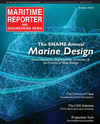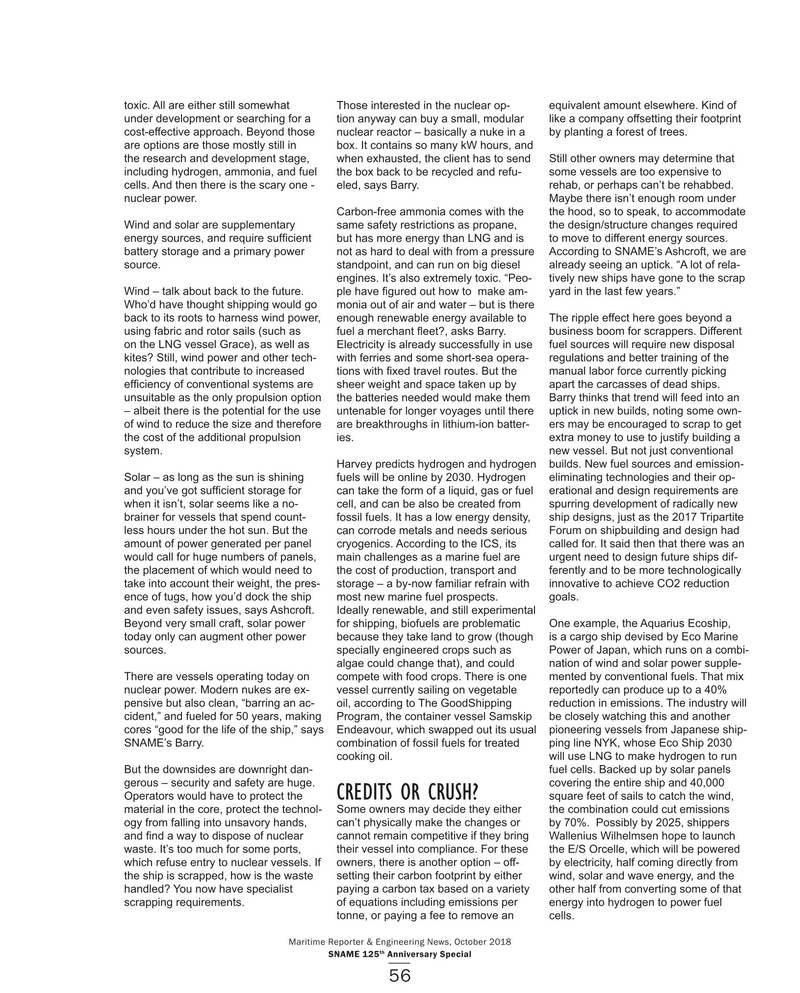
Page 56: of Maritime Reporter Magazine (October 2018)
Marine Design Annual
Read this page in Pdf, Flash or Html5 edition of October 2018 Maritime Reporter Magazine
toxic. All are either still somewhat Those interested in the nuclear op- equivalent amount elsewhere. Kind of under development or searching for a tion anyway can buy a small, modular like a company offsetting their footprint cost-effective approach. Beyond those nuclear reactor – basically a nuke in a by planting a forest of trees. are options are those mostly still in box. It contains so many kW hours, and the research and development stage, when exhausted, the client has to send Still other owners may determine that including hydrogen, ammonia, and fuel the box back to be recycled and refu- some vessels are too expensive to cells. And then there is the scary one - eled, says Barry. rehab, or perhaps can’t be rehabbed. nuclear power. Maybe there isn’t enough room under
Carbon-free ammonia comes with the the hood, so to speak, to accommodate
Wind and solar are supplementary same safety restrictions as propane, the design/structure changes required energy sources, and require suf? cient but has more energy than LNG and is to move to different energy sources. battery storage and a primary power not as hard to deal with from a pressure According to SNAME’s Ashcroft, we are source. standpoint, and can run on big diesel already seeing an uptick. “A lot of rela- engines. It’s also extremely toxic. “Peo- tively new ships have gone to the scrap
Wind – talk about back to the future. ple have ? gured out how to make am- yard in the last few years.”
Who’d have thought shipping would go monia out of air and water – but is there back to its roots to harness wind power, enough renewable energy available to The ripple effect here goes beyond a using fabric and rotor sails (such as fuel a merchant ? eet?, asks Barry. business boom for scrappers. Different on the LNG vessel Grace), as well as Electricity is already successfully in use fuel sources will require new disposal kites? Still, wind power and other tech- with ferries and some short-sea opera- regulations and better training of the nologies that contribute to increased tions with ? xed travel routes. But the manual labor force currently picking ef? ciency of conventional systems are sheer weight and space taken up by apart the carcasses of dead ships. unsuitable as the only propulsion option the batteries needed would make them Barry thinks that trend will feed into an – albeit there is the potential for the use untenable for longer voyages until there uptick in new builds, noting some own- of wind to reduce the size and therefore are breakthroughs in lithium-ion batter- ers may be encouraged to scrap to get the cost of the additional propulsion ies. extra money to use to justify building a system. new vessel. But not just conventional
Harvey predicts hydrogen and hydrogen builds. New fuel sources and emission-
Solar – as long as the sun is shining fuels will be online by 2030. Hydrogen eliminating technologies and their op- and you’ve got suf? cient storage for can take the form of a liquid, gas or fuel erational and design requirements are when it isn’t, solar seems like a no- cell, and can be also be created from spurring development of radically new brainer for vessels that spend count- fossil fuels. It has a low energy density, ship designs, just as the 2017 Tripartite less hours under the hot sun. But the can corrode metals and needs serious Forum on shipbuilding and design had amount of power generated per panel cryogenics. According to the ICS, its called for. It said then that there was an would call for huge numbers of panels, main challenges as a marine fuel are urgent need to design future ships dif- the placement of which would need to the cost of production, transport and ferently and to be more technologically take into account their weight, the pres- storage – a by-now familiar refrain with innovative to achieve CO2 reduction ence of tugs, how you’d dock the ship most new marine fuel prospects. goals. and even safety issues, says Ashcroft. Ideally renewable, and still experimental
Beyond very small craft, solar power for shipping, biofuels are problematic One example, the Aquarius Ecoship, today only can augment other power because they take land to grow (though is a cargo ship devised by Eco Marine sources. specially engineered crops such as Power of Japan, which runs on a combi- algae could change that), and could nation of wind and solar power supple-
There are vessels operating today on compete with food crops. There is one mented by conventional fuels. That mix nuclear power. Modern nukes are ex- vessel currently sailing on vegetable reportedly can produce up to a 40% pensive but also clean, “barring an ac- oil, according to The GoodShipping reduction in emissions. The industry will cident,” and fueled for 50 years, making Program, the container vessel Samskip be closely watching this and another cores “good for the life of the ship,” says Endeavour, which swapped out its usual pioneering vessels from Japanese ship-
SNAME’s Barry. combination of fossil fuels for treated ping line NYK, whose Eco Ship 2030 cooking oil. will use LNG to make hydrogen to run
But the downsides are downright dan- fuel cells. Backed up by solar panels gerous – security and safety are huge. covering the entire ship and 40,000
CREDITS OR CRUSH?
Operators would have to protect the square feet of sails to catch the wind, material in the core, protect the technol- Some owners may decide they either the combination could cut emissions ogy from falling into unsavory hands, can’t physically make the changes or by 70%. Possibly by 2025, shippers and ? nd a way to dispose of nuclear cannot remain competitive if they bring Wallenius Wilhelmsen hope to launch waste. It’s too much for some ports, their vessel into compliance. For these the E/S Orcelle, which will be powered which refuse entry to nuclear vessels. If owners, there is another option – off- by electricity, half coming directly from the ship is scrapped, how is the waste setting their carbon footprint by either wind, solar and wave energy, and the handled? You now have specialist paying a carbon tax based on a variety other half from converting some of that scrapping requirements. of equations including emissions per energy into hydrogen to power fuel tonne, or paying a fee to remove an cells.
Maritime Reporter & Engineering News, October 2018 th
SNAME 125 Anniversary Special 56
MR #10 (50-57).indd 56 MR #10 (50-57).indd 56 10/5/2018 10:45:13 AM10/5/2018 10:45:13 AM

 55
55

 57
57
